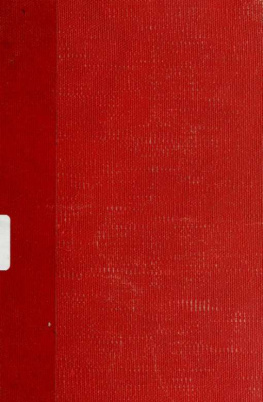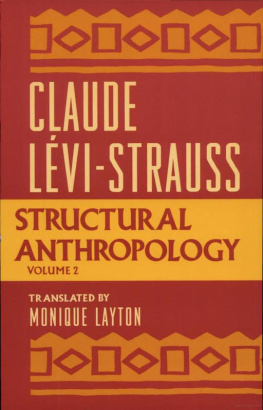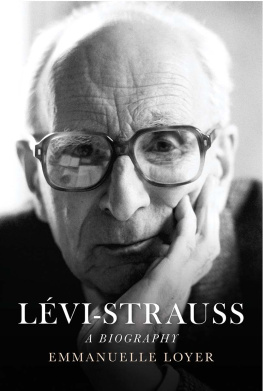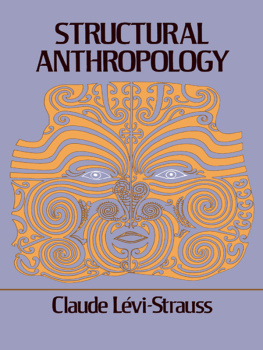PENGUIN  CLASSICS
CLASSICS
TRISTES TROPIQUES
CLAUDE LVI-STRAUSS , the founder of structural anthropology, was born in Belgium in 1908. He studied at the University of Paris, including readings in sociology, took a degree in law and was received at the agrgation in philosophy. After teaching in a lyce, he was appointed in 1934 to a post as Professor of Sociology at the University of So Paulo in Brazil. During his tenure there, he made several expeditions to the countrys interior, where he conducted his first fieldwork. In 1941 he began teaching at the New School for Social Research in New York City, and served from 1946 to 1947 as the cultural counsellor to the French embassy in Washington. Lvi-Strauss began publishing his work in the midforties. He was appointed to the specially created Chair of Social Anthropology at the Collge de France in 1959. In 1968 he was awarded the Gold Medal of the Centre National de la Recherche Scientifique, and in 1973 he was elected to the French Academy. His many published works include Structural Anthropology; Totemism; The Savage Mind; The Raw and the Cooked; From Honey to Ashes; The Origin of Table Manners; The Naked Man; Myth and Meaning; and Look, Listen, Read. He died on October 30, 2009, a few weeks shy of his 101st birthday.
JOHN WEIGHTMAN and DOREEN WEIGHTMAN together translated several important anthropological works of Claude Lvi-Strauss and a book about Rousseau by Jean Guehenno.
PATRICK WILCKEN is the author of Claude Lvi-Strauss: The Poet in the Laboratory and Empire Adrift: The Portuguese Court in Rio de Janeiro, 18081821. He studied anthropology at Goldsmiths College, London University, and now works as a researcher on the Brazil desk at Amnesty International. He lives in London.
CLAUDE LVI-STRAUSS
Tristes Tropiques
Translated by
JOHN WEIGHTMAN and DOREEN WEIGHTMAN
Introduction and Notes by
PATRICK WILCKEN
PENGUIN BOOKS
PENGUIN BOOKS
Published by the Penguin Group
Penguin Group (USA) Inc., 375 Hudson Street, New York, New York 10014, U.S.A.
Penguin Group (Canada), 90 Eglinton Avenue East, Suite 700, Toronto,
Ontario, Canada M4P 2Y3 (a division of Pearson Penguin Canada Inc.)
Penguin Books Ltd, 80 Strand, London WC2R 0RL, England
Penguin Ireland, 25 St Stephens Green, Dublin 2, Ireland (a division of Penguin Books Ltd)
Penguin Group (Australia), 250 Camberwell Road, Camberwell,
Victoria 3124, Australia (a division of Pearson Australia Group Pty Ltd)
Penguin Books India Pvt Ltd, 11 Community Centre,
Panchsheel Park, New Delhi 110 017, India Penguin Group (NZ), 67 Apollo Drive, Rosedale, Auckland 0632,
New Zealand (a division of Pearson New Zealand Ltd)
Penguin Books (South Africa) (Pty) Ltd, 24 Sturdee Avenue,
Rosebank, Johannesburg 2196, South Africa
Penguin Books Ltd, Registered Offices:
80 Strand, London WC2R 0RL, England
This translation first published in Great Britain by Jonathan Cape 1973 Published in the United States of America by Atheneum Publishers 1974 Published in Penguin Books 1992 This edition with an introduction by Patrick Wilcken published 2012
1 3 5 7 9 10 8 6 4 2
Copyright Librarie Plon, 1955
English translation copyright Jonathan Cape Limited, 1973
Introduction copyright Patrick Wilcken, 2012
All rights reserved
A previous English translation of this work, from which of the French were omitted, was published in the United States by Criterion Books and reprinted by Atheneum.
LIBRARY OF CONGRESS CATALOGING IN PUBLICATION DATA
Lvi-Strauss, Claude.
[Tristes tropiques. English]
Tristes tropiques/Claude Lvi-Strauss: translated from
the French by John and Doreen Weightman.
p. cm.
ISBN: 978-1-101-57560-4
1. Indians of South AmericaBrazil. 2. BrazilDescription and travel19511980. I. Title.
F2520.L4813 1992
981.00498dc20 9144515
Printed in the United States of America
Set in Old Style 7 Std.
Except in the United States of America, this book is sold subject to the condition that it shall not,
by way of trade or otherwise, be lent, resold, hired out, or otherwise circulated without the publishers
prior consent in any form of binding or cover other than that in which it is published and without
a similar condition including this condition being imposed on the subsequent purchaser.
The scanning, uploading and distribution of this book via the Internet or via any other means
without the permission of the publisher is illegal and punishable by law. Please purchase only
authorized electronic editions, and do not participate in or encourage electronic piracy
of copyrighted materials. Your support of the authors rights is appreciated.

Version_2
TO LAURENT
Nec minus ergo ante haec quam tu cecidere, cadentque.
LUCRETIUS,
De rerum natura, III, 969
Plates
CADUVEO
A Caduveo woman with a painted face
A Caduveo belle in 1895 (taken from Boggiani)
Facial painting: an original drawing by a Caduveo woman
Two further facial paintings drawn by natives
A Caduveo girl made ready for her puberty rites
BORORO
The authors best informant, in ceremonial dress
A meal in the Mens House
Bringing out the mariddo
A funeral ceremony (photograph by M. Ren Silz)
NAMBIKWARA
The Nambikwara group on the move
Saban, the sorcerer
The chief of the Wakletou
A Nambikwara woman piercing mother-of-pearl from river shells
The siesta
The native method of carrying a baby
Day-dreaming
A Nambikwara smile
TUPI-KAWAHIB
The Mund village square
A Mund woman with her child
A Tupi-Kawahib man (Potien) skinning a monkey
Taperahi, the Tupi-Kawahib chief
Kunhatsin, Taperahis chief wife, carrying her child
Pwcreza, Taperahis son
Penhana, the young wife shared by the two brothers
Maruabai, the co-wife of Chief Taperahi
Figures
| 1 An ancient figa, found at Pompeii |
| 2 A calvary cross, from the State of So Paulo |
| 3 The axle of an ox-cart |
| 4 Caingang pottery |
| 5 A water-jar |
| 6 Three specimens of Caduveo pottery |
| 7 Two wooden statuettes |
| 8 Caduveo jewellery |
| 9 Two statuettes representing mythological figures |
| 10 and 11 Caduveo patterns |
| 1217 Motifs used in body painting |
| 18 and 19 Drawings made by a Caduveo boy |
| 20 Two face-paintings |
| 21 A pattern painted on leather |
| 22 and 23 Body paintings, as recorded in 1895 and 1935 |
| 24 and 25 Motifs used in face- and body-painting |
| 26 A facial painting |
| 27 The penis sheath |
| 28 A lip ornament and earrings |
| 29 Plan of Kejara village |
| 30 A wooden club for killing fish |
| 31 Bows with clan decorations |
| 32 Arrow-ends with clan decorations |
| 33 Emblazoned penis sheaths |
| 34 A black pottery bowl |
| 35 Two specimens of the Bororo pocket-knife |
| 36 A pendant decorated with jaguars teeth |
| 37 Crowns of dried and painted straw |











 CLASSICS
CLASSICS